Classical Strategic Thought: Applicability to Modern Cyber Warfare
VerifiedAdded on 2023/05/29
|10
|3025
|341
Essay
AI Summary
This essay examines the enduring relevance of classical strategic thought in the context of modern warfare, focusing on cyberwar as a case study. It analyzes the ideas of theorists such as Sun Tzu, Clausewitz, and Jomini, as well as modern theorists like Douhet and Warden, to determine their applicability to contemporary conflicts. The essay argues that while classical strategic principles offer valuable insights, the unique dynamics of cyberwar necessitate new approaches and policies. It explores the strategic choices policymakers face in addressing cyber threats, including defining viable targets, dealing with non-state actors, and determining the balance between defensive and offensive strategies. The essay concludes that a clear and well-defined policy stance is crucial for effectively responding to future warfare challenges, even amidst technological advancements. Desklib provides access to this and other solved assignments for students.
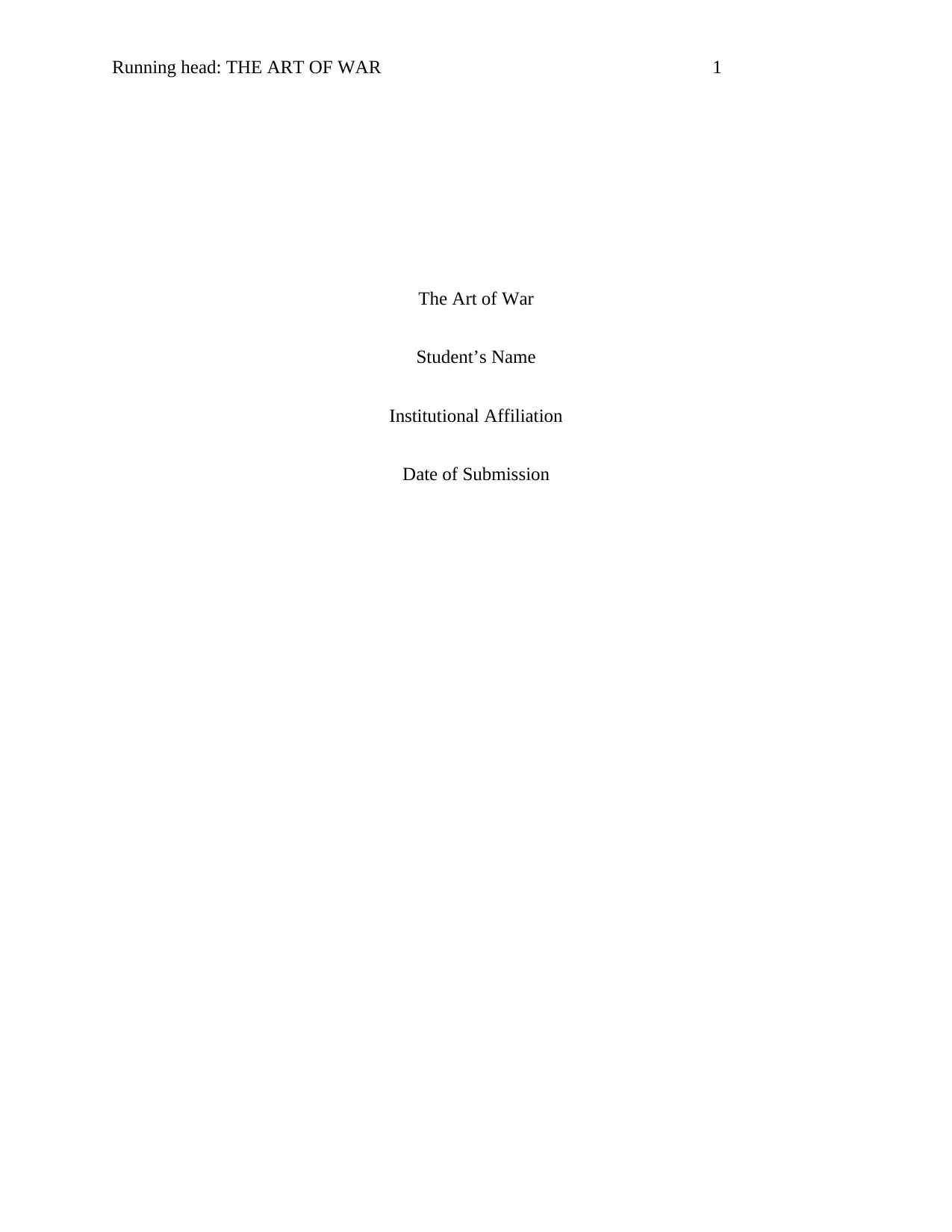
Running head: THE ART OF WAR 1
The Art of War
Student’s Name
Institutional Affiliation
Date of Submission
The Art of War
Student’s Name
Institutional Affiliation
Date of Submission
Paraphrase This Document
Need a fresh take? Get an instant paraphrase of this document with our AI Paraphraser
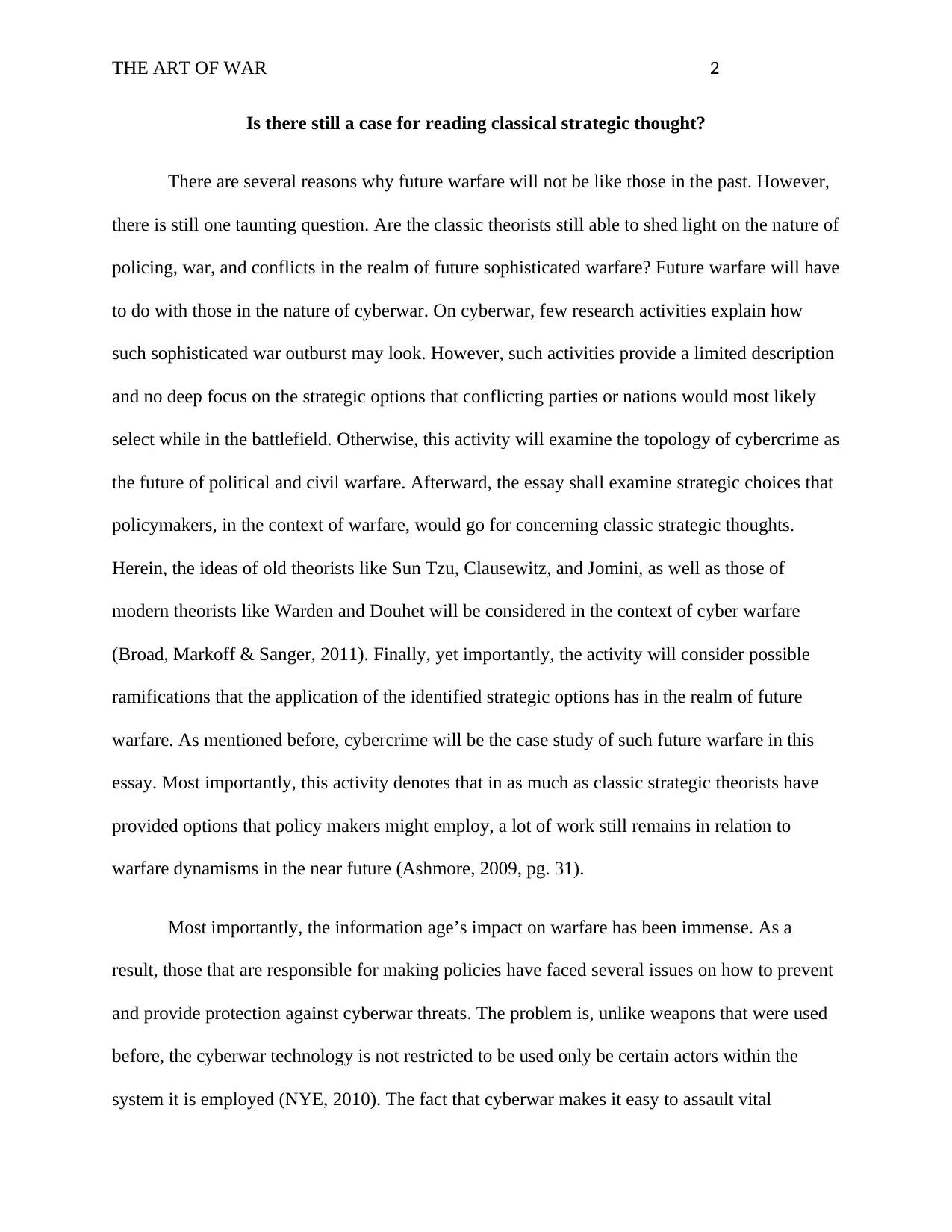
THE ART OF WAR 2
Is there still a case for reading classical strategic thought?
There are several reasons why future warfare will not be like those in the past. However,
there is still one taunting question. Are the classic theorists still able to shed light on the nature of
policing, war, and conflicts in the realm of future sophisticated warfare? Future warfare will have
to do with those in the nature of cyberwar. On cyberwar, few research activities explain how
such sophisticated war outburst may look. However, such activities provide a limited description
and no deep focus on the strategic options that conflicting parties or nations would most likely
select while in the battlefield. Otherwise, this activity will examine the topology of cybercrime as
the future of political and civil warfare. Afterward, the essay shall examine strategic choices that
policymakers, in the context of warfare, would go for concerning classic strategic thoughts.
Herein, the ideas of old theorists like Sun Tzu, Clausewitz, and Jomini, as well as those of
modern theorists like Warden and Douhet will be considered in the context of cyber warfare
(Broad, Markoff & Sanger, 2011). Finally, yet importantly, the activity will consider possible
ramifications that the application of the identified strategic options has in the realm of future
warfare. As mentioned before, cybercrime will be the case study of such future warfare in this
essay. Most importantly, this activity denotes that in as much as classic strategic theorists have
provided options that policy makers might employ, a lot of work still remains in relation to
warfare dynamisms in the near future (Ashmore, 2009, pg. 31).
Most importantly, the information age’s impact on warfare has been immense. As a
result, those that are responsible for making policies have faced several issues on how to prevent
and provide protection against cyberwar threats. The problem is, unlike weapons that were used
before, the cyberwar technology is not restricted to be used only be certain actors within the
system it is employed (NYE, 2010). The fact that cyberwar makes it easy to assault vital
Is there still a case for reading classical strategic thought?
There are several reasons why future warfare will not be like those in the past. However,
there is still one taunting question. Are the classic theorists still able to shed light on the nature of
policing, war, and conflicts in the realm of future sophisticated warfare? Future warfare will have
to do with those in the nature of cyberwar. On cyberwar, few research activities explain how
such sophisticated war outburst may look. However, such activities provide a limited description
and no deep focus on the strategic options that conflicting parties or nations would most likely
select while in the battlefield. Otherwise, this activity will examine the topology of cybercrime as
the future of political and civil warfare. Afterward, the essay shall examine strategic choices that
policymakers, in the context of warfare, would go for concerning classic strategic thoughts.
Herein, the ideas of old theorists like Sun Tzu, Clausewitz, and Jomini, as well as those of
modern theorists like Warden and Douhet will be considered in the context of cyber warfare
(Broad, Markoff & Sanger, 2011). Finally, yet importantly, the activity will consider possible
ramifications that the application of the identified strategic options has in the realm of future
warfare. As mentioned before, cybercrime will be the case study of such future warfare in this
essay. Most importantly, this activity denotes that in as much as classic strategic theorists have
provided options that policy makers might employ, a lot of work still remains in relation to
warfare dynamisms in the near future (Ashmore, 2009, pg. 31).
Most importantly, the information age’s impact on warfare has been immense. As a
result, those that are responsible for making policies have faced several issues on how to prevent
and provide protection against cyberwar threats. The problem is, unlike weapons that were used
before, the cyberwar technology is not restricted to be used only be certain actors within the
system it is employed (NYE, 2010). The fact that cyberwar makes it easy to assault vital
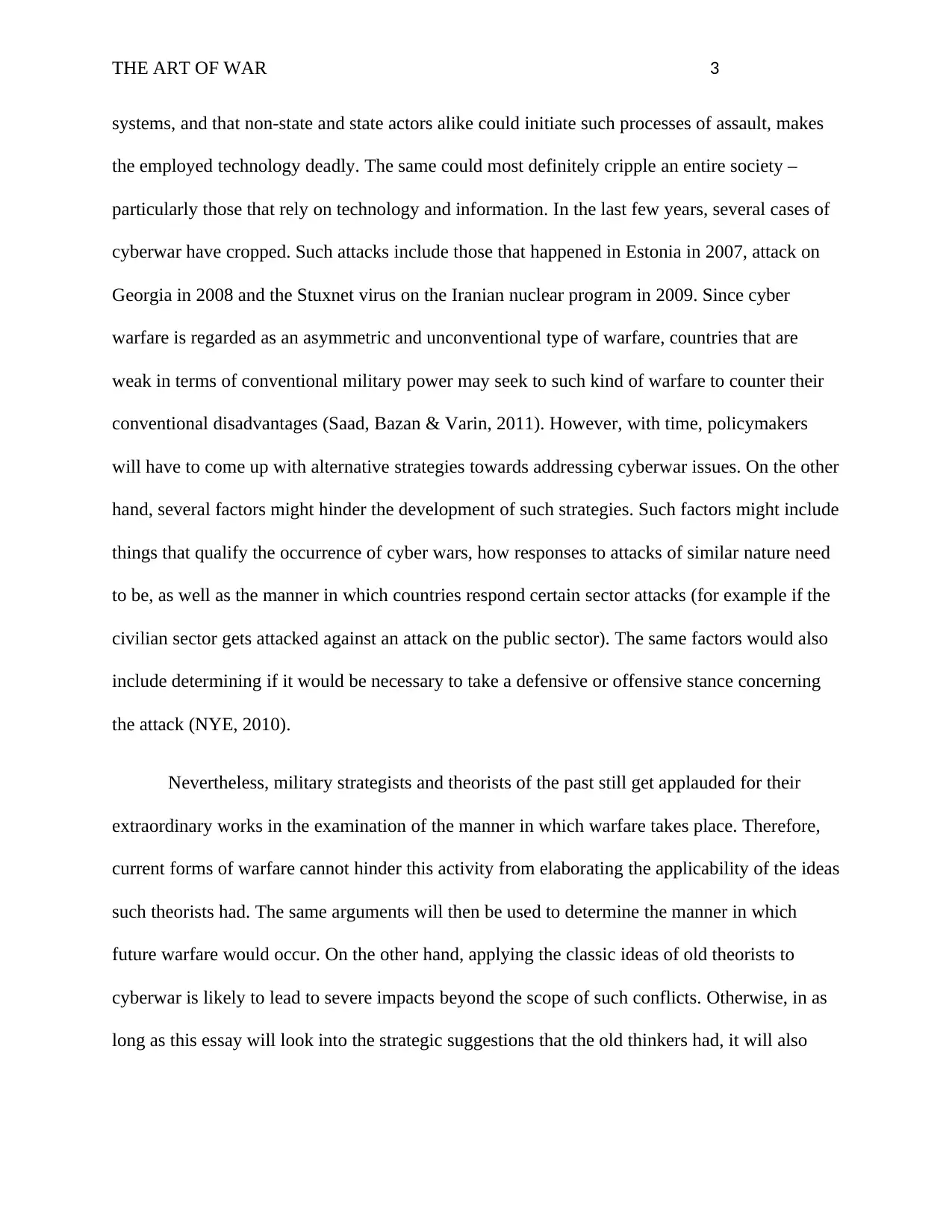
THE ART OF WAR 3
systems, and that non-state and state actors alike could initiate such processes of assault, makes
the employed technology deadly. The same could most definitely cripple an entire society –
particularly those that rely on technology and information. In the last few years, several cases of
cyberwar have cropped. Such attacks include those that happened in Estonia in 2007, attack on
Georgia in 2008 and the Stuxnet virus on the Iranian nuclear program in 2009. Since cyber
warfare is regarded as an asymmetric and unconventional type of warfare, countries that are
weak in terms of conventional military power may seek to such kind of warfare to counter their
conventional disadvantages (Saad, Bazan & Varin, 2011). However, with time, policymakers
will have to come up with alternative strategies towards addressing cyberwar issues. On the other
hand, several factors might hinder the development of such strategies. Such factors might include
things that qualify the occurrence of cyber wars, how responses to attacks of similar nature need
to be, as well as the manner in which countries respond certain sector attacks (for example if the
civilian sector gets attacked against an attack on the public sector). The same factors would also
include determining if it would be necessary to take a defensive or offensive stance concerning
the attack (NYE, 2010).
Nevertheless, military strategists and theorists of the past still get applauded for their
extraordinary works in the examination of the manner in which warfare takes place. Therefore,
current forms of warfare cannot hinder this activity from elaborating the applicability of the ideas
such theorists had. The same arguments will then be used to determine the manner in which
future warfare would occur. On the other hand, applying the classic ideas of old theorists to
cyberwar is likely to lead to severe impacts beyond the scope of such conflicts. Otherwise, in as
long as this essay will look into the strategic suggestions that the old thinkers had, it will also
systems, and that non-state and state actors alike could initiate such processes of assault, makes
the employed technology deadly. The same could most definitely cripple an entire society –
particularly those that rely on technology and information. In the last few years, several cases of
cyberwar have cropped. Such attacks include those that happened in Estonia in 2007, attack on
Georgia in 2008 and the Stuxnet virus on the Iranian nuclear program in 2009. Since cyber
warfare is regarded as an asymmetric and unconventional type of warfare, countries that are
weak in terms of conventional military power may seek to such kind of warfare to counter their
conventional disadvantages (Saad, Bazan & Varin, 2011). However, with time, policymakers
will have to come up with alternative strategies towards addressing cyberwar issues. On the other
hand, several factors might hinder the development of such strategies. Such factors might include
things that qualify the occurrence of cyber wars, how responses to attacks of similar nature need
to be, as well as the manner in which countries respond certain sector attacks (for example if the
civilian sector gets attacked against an attack on the public sector). The same factors would also
include determining if it would be necessary to take a defensive or offensive stance concerning
the attack (NYE, 2010).
Nevertheless, military strategists and theorists of the past still get applauded for their
extraordinary works in the examination of the manner in which warfare takes place. Therefore,
current forms of warfare cannot hinder this activity from elaborating the applicability of the ideas
such theorists had. The same arguments will then be used to determine the manner in which
future warfare would occur. On the other hand, applying the classic ideas of old theorists to
cyberwar is likely to lead to severe impacts beyond the scope of such conflicts. Otherwise, in as
long as this essay will look into the strategic suggestions that the old thinkers had, it will also
⊘ This is a preview!⊘
Do you want full access?
Subscribe today to unlock all pages.

Trusted by 1+ million students worldwide
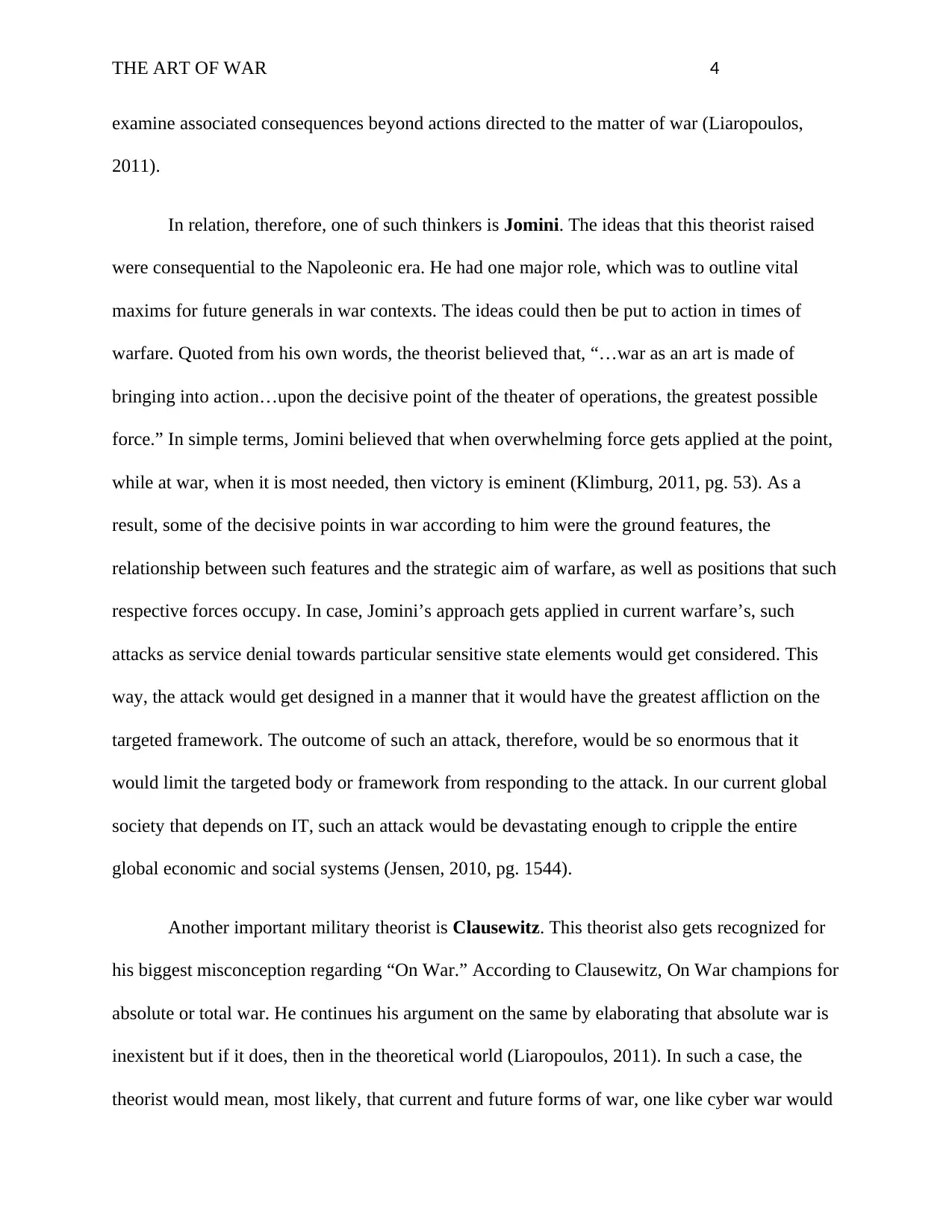
THE ART OF WAR 4
examine associated consequences beyond actions directed to the matter of war (Liaropoulos,
2011).
In relation, therefore, one of such thinkers is Jomini. The ideas that this theorist raised
were consequential to the Napoleonic era. He had one major role, which was to outline vital
maxims for future generals in war contexts. The ideas could then be put to action in times of
warfare. Quoted from his own words, the theorist believed that, “…war as an art is made of
bringing into action…upon the decisive point of the theater of operations, the greatest possible
force.” In simple terms, Jomini believed that when overwhelming force gets applied at the point,
while at war, when it is most needed, then victory is eminent (Klimburg, 2011, pg. 53). As a
result, some of the decisive points in war according to him were the ground features, the
relationship between such features and the strategic aim of warfare, as well as positions that such
respective forces occupy. In case, Jomini’s approach gets applied in current warfare’s, such
attacks as service denial towards particular sensitive state elements would get considered. This
way, the attack would get designed in a manner that it would have the greatest affliction on the
targeted framework. The outcome of such an attack, therefore, would be so enormous that it
would limit the targeted body or framework from responding to the attack. In our current global
society that depends on IT, such an attack would be devastating enough to cripple the entire
global economic and social systems (Jensen, 2010, pg. 1544).
Another important military theorist is Clausewitz. This theorist also gets recognized for
his biggest misconception regarding “On War.” According to Clausewitz, On War champions for
absolute or total war. He continues his argument on the same by elaborating that absolute war is
inexistent but if it does, then in the theoretical world (Liaropoulos, 2011). In such a case, the
theorist would mean, most likely, that current and future forms of war, one like cyber war would
examine associated consequences beyond actions directed to the matter of war (Liaropoulos,
2011).
In relation, therefore, one of such thinkers is Jomini. The ideas that this theorist raised
were consequential to the Napoleonic era. He had one major role, which was to outline vital
maxims for future generals in war contexts. The ideas could then be put to action in times of
warfare. Quoted from his own words, the theorist believed that, “…war as an art is made of
bringing into action…upon the decisive point of the theater of operations, the greatest possible
force.” In simple terms, Jomini believed that when overwhelming force gets applied at the point,
while at war, when it is most needed, then victory is eminent (Klimburg, 2011, pg. 53). As a
result, some of the decisive points in war according to him were the ground features, the
relationship between such features and the strategic aim of warfare, as well as positions that such
respective forces occupy. In case, Jomini’s approach gets applied in current warfare’s, such
attacks as service denial towards particular sensitive state elements would get considered. This
way, the attack would get designed in a manner that it would have the greatest affliction on the
targeted framework. The outcome of such an attack, therefore, would be so enormous that it
would limit the targeted body or framework from responding to the attack. In our current global
society that depends on IT, such an attack would be devastating enough to cripple the entire
global economic and social systems (Jensen, 2010, pg. 1544).
Another important military theorist is Clausewitz. This theorist also gets recognized for
his biggest misconception regarding “On War.” According to Clausewitz, On War champions for
absolute or total war. He continues his argument on the same by elaborating that absolute war is
inexistent but if it does, then in the theoretical world (Liaropoulos, 2011). In such a case, the
theorist would mean, most likely, that current and future forms of war, one like cyber war would
Paraphrase This Document
Need a fresh take? Get an instant paraphrase of this document with our AI Paraphraser
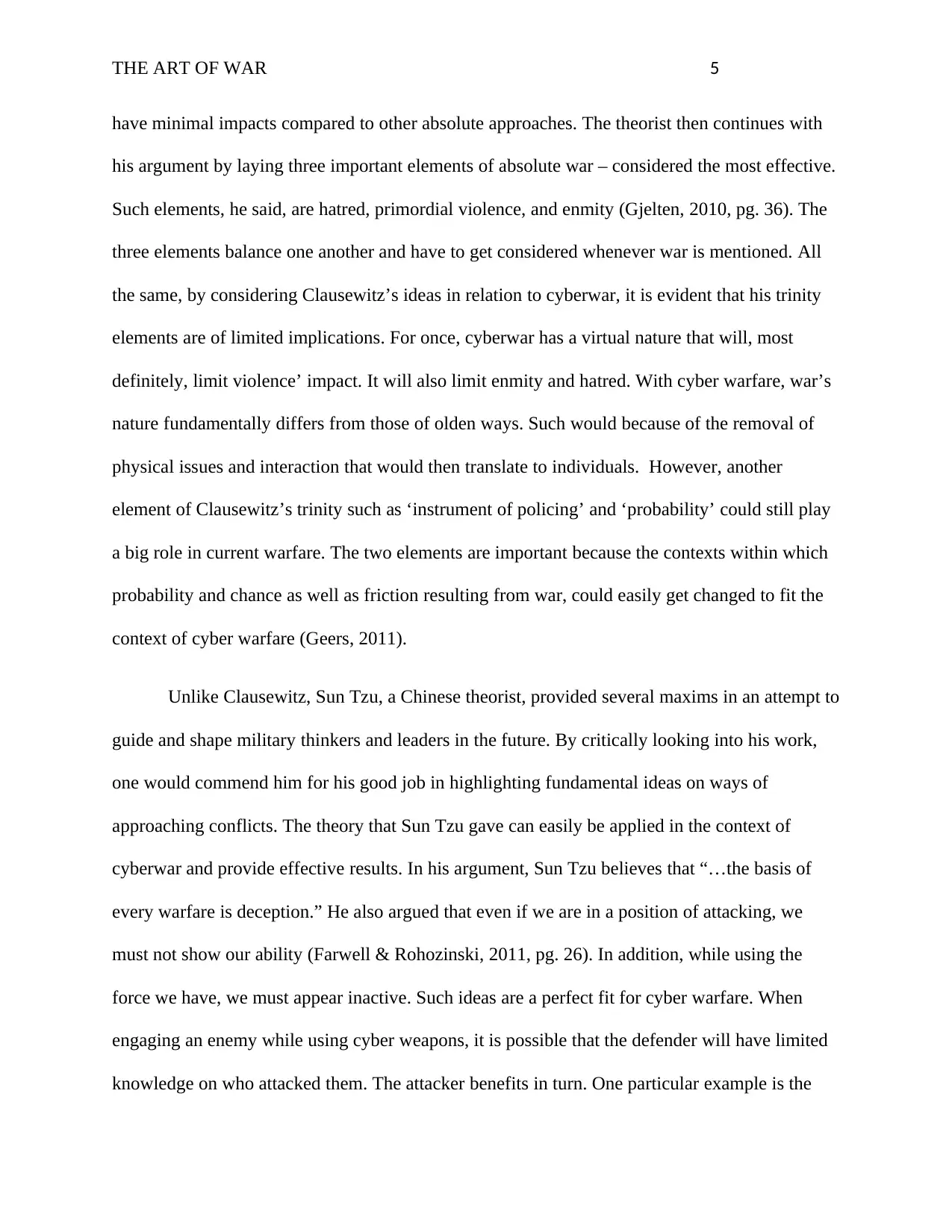
THE ART OF WAR 5
have minimal impacts compared to other absolute approaches. The theorist then continues with
his argument by laying three important elements of absolute war – considered the most effective.
Such elements, he said, are hatred, primordial violence, and enmity (Gjelten, 2010, pg. 36). The
three elements balance one another and have to get considered whenever war is mentioned. All
the same, by considering Clausewitz’s ideas in relation to cyberwar, it is evident that his trinity
elements are of limited implications. For once, cyberwar has a virtual nature that will, most
definitely, limit violence’ impact. It will also limit enmity and hatred. With cyber warfare, war’s
nature fundamentally differs from those of olden ways. Such would because of the removal of
physical issues and interaction that would then translate to individuals. However, another
element of Clausewitz’s trinity such as ‘instrument of policing’ and ‘probability’ could still play
a big role in current warfare. The two elements are important because the contexts within which
probability and chance as well as friction resulting from war, could easily get changed to fit the
context of cyber warfare (Geers, 2011).
Unlike Clausewitz, Sun Tzu, a Chinese theorist, provided several maxims in an attempt to
guide and shape military thinkers and leaders in the future. By critically looking into his work,
one would commend him for his good job in highlighting fundamental ideas on ways of
approaching conflicts. The theory that Sun Tzu gave can easily be applied in the context of
cyberwar and provide effective results. In his argument, Sun Tzu believes that “…the basis of
every warfare is deception.” He also argued that even if we are in a position of attacking, we
must not show our ability (Farwell & Rohozinski, 2011, pg. 26). In addition, while using the
force we have, we must appear inactive. Such ideas are a perfect fit for cyber warfare. When
engaging an enemy while using cyber weapons, it is possible that the defender will have limited
knowledge on who attacked them. The attacker benefits in turn. One particular example is the
have minimal impacts compared to other absolute approaches. The theorist then continues with
his argument by laying three important elements of absolute war – considered the most effective.
Such elements, he said, are hatred, primordial violence, and enmity (Gjelten, 2010, pg. 36). The
three elements balance one another and have to get considered whenever war is mentioned. All
the same, by considering Clausewitz’s ideas in relation to cyberwar, it is evident that his trinity
elements are of limited implications. For once, cyberwar has a virtual nature that will, most
definitely, limit violence’ impact. It will also limit enmity and hatred. With cyber warfare, war’s
nature fundamentally differs from those of olden ways. Such would because of the removal of
physical issues and interaction that would then translate to individuals. However, another
element of Clausewitz’s trinity such as ‘instrument of policing’ and ‘probability’ could still play
a big role in current warfare. The two elements are important because the contexts within which
probability and chance as well as friction resulting from war, could easily get changed to fit the
context of cyber warfare (Geers, 2011).
Unlike Clausewitz, Sun Tzu, a Chinese theorist, provided several maxims in an attempt to
guide and shape military thinkers and leaders in the future. By critically looking into his work,
one would commend him for his good job in highlighting fundamental ideas on ways of
approaching conflicts. The theory that Sun Tzu gave can easily be applied in the context of
cyberwar and provide effective results. In his argument, Sun Tzu believes that “…the basis of
every warfare is deception.” He also argued that even if we are in a position of attacking, we
must not show our ability (Farwell & Rohozinski, 2011, pg. 26). In addition, while using the
force we have, we must appear inactive. Such ideas are a perfect fit for cyber warfare. When
engaging an enemy while using cyber weapons, it is possible that the defender will have limited
knowledge on who attacked them. The attacker benefits in turn. One particular example is the
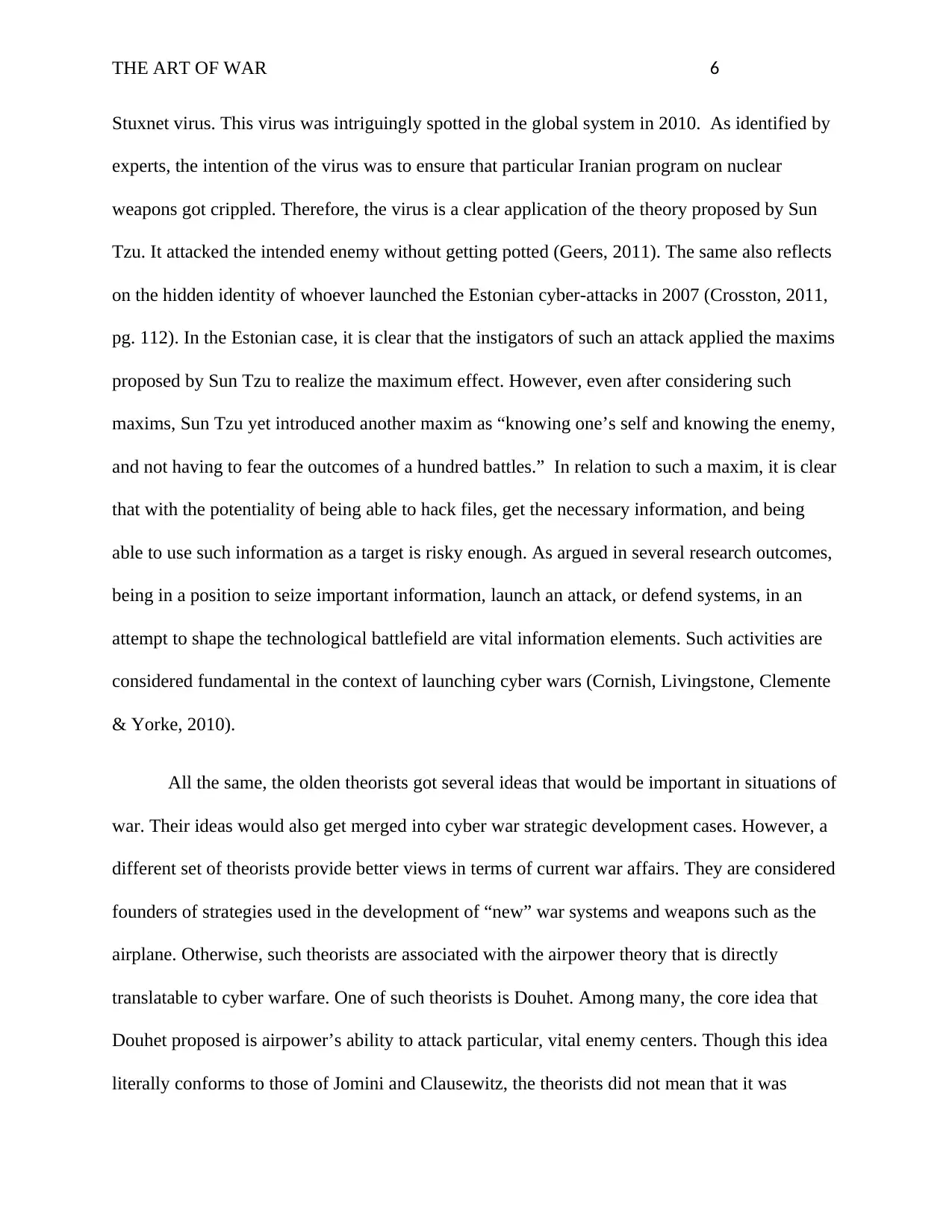
THE ART OF WAR 6
Stuxnet virus. This virus was intriguingly spotted in the global system in 2010. As identified by
experts, the intention of the virus was to ensure that particular Iranian program on nuclear
weapons got crippled. Therefore, the virus is a clear application of the theory proposed by Sun
Tzu. It attacked the intended enemy without getting potted (Geers, 2011). The same also reflects
on the hidden identity of whoever launched the Estonian cyber-attacks in 2007 (Crosston, 2011,
pg. 112). In the Estonian case, it is clear that the instigators of such an attack applied the maxims
proposed by Sun Tzu to realize the maximum effect. However, even after considering such
maxims, Sun Tzu yet introduced another maxim as “knowing one’s self and knowing the enemy,
and not having to fear the outcomes of a hundred battles.” In relation to such a maxim, it is clear
that with the potentiality of being able to hack files, get the necessary information, and being
able to use such information as a target is risky enough. As argued in several research outcomes,
being in a position to seize important information, launch an attack, or defend systems, in an
attempt to shape the technological battlefield are vital information elements. Such activities are
considered fundamental in the context of launching cyber wars (Cornish, Livingstone, Clemente
& Yorke, 2010).
All the same, the olden theorists got several ideas that would be important in situations of
war. Their ideas would also get merged into cyber war strategic development cases. However, a
different set of theorists provide better views in terms of current war affairs. They are considered
founders of strategies used in the development of “new” war systems and weapons such as the
airplane. Otherwise, such theorists are associated with the airpower theory that is directly
translatable to cyber warfare. One of such theorists is Douhet. Among many, the core idea that
Douhet proposed is airpower’s ability to attack particular, vital enemy centers. Though this idea
literally conforms to those of Jomini and Clausewitz, the theorists did not mean that it was
Stuxnet virus. This virus was intriguingly spotted in the global system in 2010. As identified by
experts, the intention of the virus was to ensure that particular Iranian program on nuclear
weapons got crippled. Therefore, the virus is a clear application of the theory proposed by Sun
Tzu. It attacked the intended enemy without getting potted (Geers, 2011). The same also reflects
on the hidden identity of whoever launched the Estonian cyber-attacks in 2007 (Crosston, 2011,
pg. 112). In the Estonian case, it is clear that the instigators of such an attack applied the maxims
proposed by Sun Tzu to realize the maximum effect. However, even after considering such
maxims, Sun Tzu yet introduced another maxim as “knowing one’s self and knowing the enemy,
and not having to fear the outcomes of a hundred battles.” In relation to such a maxim, it is clear
that with the potentiality of being able to hack files, get the necessary information, and being
able to use such information as a target is risky enough. As argued in several research outcomes,
being in a position to seize important information, launch an attack, or defend systems, in an
attempt to shape the technological battlefield are vital information elements. Such activities are
considered fundamental in the context of launching cyber wars (Cornish, Livingstone, Clemente
& Yorke, 2010).
All the same, the olden theorists got several ideas that would be important in situations of
war. Their ideas would also get merged into cyber war strategic development cases. However, a
different set of theorists provide better views in terms of current war affairs. They are considered
founders of strategies used in the development of “new” war systems and weapons such as the
airplane. Otherwise, such theorists are associated with the airpower theory that is directly
translatable to cyber warfare. One of such theorists is Douhet. Among many, the core idea that
Douhet proposed is airpower’s ability to attack particular, vital enemy centers. Though this idea
literally conforms to those of Jomini and Clausewitz, the theorists did not mean that it was
⊘ This is a preview!⊘
Do you want full access?
Subscribe today to unlock all pages.

Trusted by 1+ million students worldwide
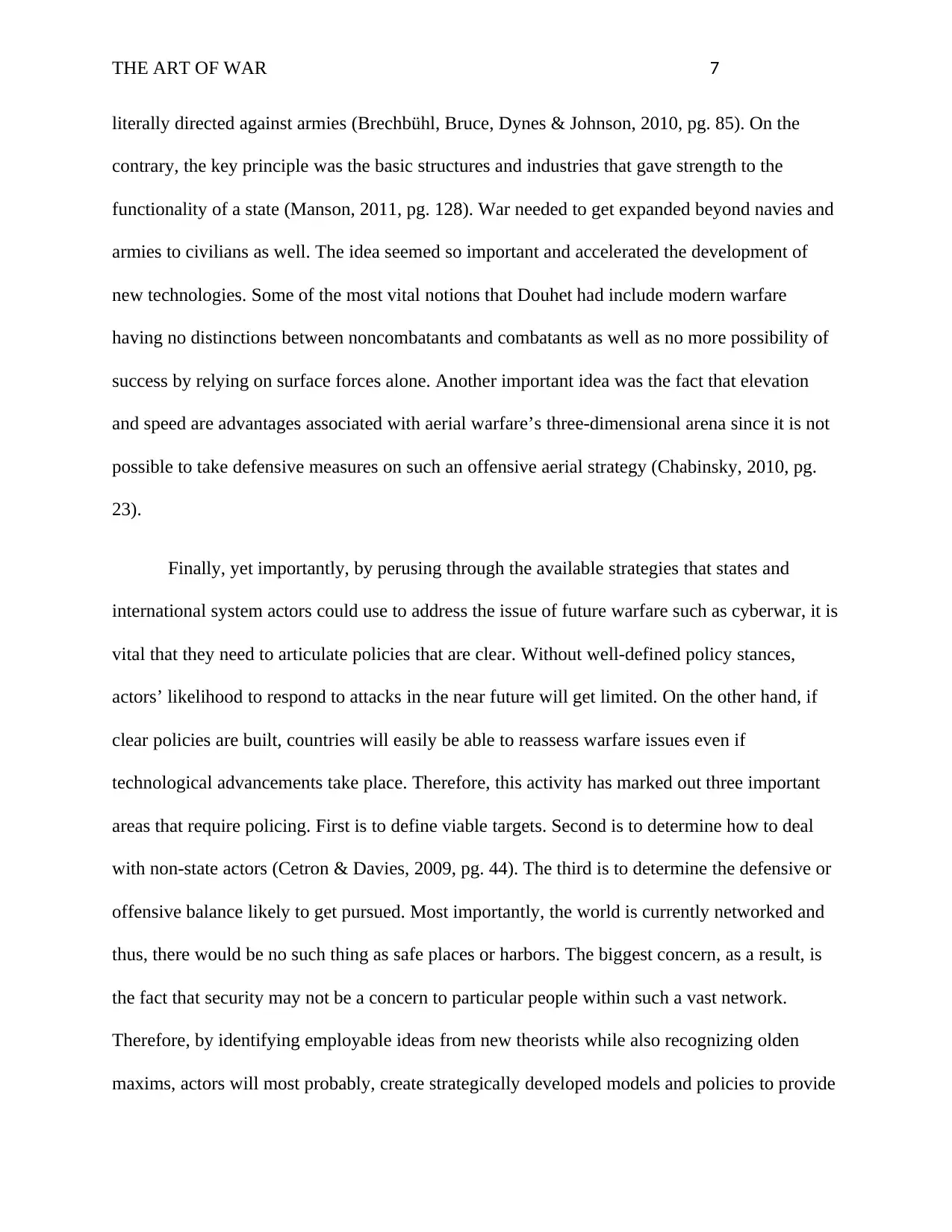
THE ART OF WAR 7
literally directed against armies (Brechbühl, Bruce, Dynes & Johnson, 2010, pg. 85). On the
contrary, the key principle was the basic structures and industries that gave strength to the
functionality of a state (Manson, 2011, pg. 128). War needed to get expanded beyond navies and
armies to civilians as well. The idea seemed so important and accelerated the development of
new technologies. Some of the most vital notions that Douhet had include modern warfare
having no distinctions between noncombatants and combatants as well as no more possibility of
success by relying on surface forces alone. Another important idea was the fact that elevation
and speed are advantages associated with aerial warfare’s three-dimensional arena since it is not
possible to take defensive measures on such an offensive aerial strategy (Chabinsky, 2010, pg.
23).
Finally, yet importantly, by perusing through the available strategies that states and
international system actors could use to address the issue of future warfare such as cyberwar, it is
vital that they need to articulate policies that are clear. Without well-defined policy stances,
actors’ likelihood to respond to attacks in the near future will get limited. On the other hand, if
clear policies are built, countries will easily be able to reassess warfare issues even if
technological advancements take place. Therefore, this activity has marked out three important
areas that require policing. First is to define viable targets. Second is to determine how to deal
with non-state actors (Cetron & Davies, 2009, pg. 44). The third is to determine the defensive or
offensive balance likely to get pursued. Most importantly, the world is currently networked and
thus, there would be no such thing as safe places or harbors. The biggest concern, as a result, is
the fact that security may not be a concern to particular people within such a vast network.
Therefore, by identifying employable ideas from new theorists while also recognizing olden
maxims, actors will most probably, create strategically developed models and policies to provide
literally directed against armies (Brechbühl, Bruce, Dynes & Johnson, 2010, pg. 85). On the
contrary, the key principle was the basic structures and industries that gave strength to the
functionality of a state (Manson, 2011, pg. 128). War needed to get expanded beyond navies and
armies to civilians as well. The idea seemed so important and accelerated the development of
new technologies. Some of the most vital notions that Douhet had include modern warfare
having no distinctions between noncombatants and combatants as well as no more possibility of
success by relying on surface forces alone. Another important idea was the fact that elevation
and speed are advantages associated with aerial warfare’s three-dimensional arena since it is not
possible to take defensive measures on such an offensive aerial strategy (Chabinsky, 2010, pg.
23).
Finally, yet importantly, by perusing through the available strategies that states and
international system actors could use to address the issue of future warfare such as cyberwar, it is
vital that they need to articulate policies that are clear. Without well-defined policy stances,
actors’ likelihood to respond to attacks in the near future will get limited. On the other hand, if
clear policies are built, countries will easily be able to reassess warfare issues even if
technological advancements take place. Therefore, this activity has marked out three important
areas that require policing. First is to define viable targets. Second is to determine how to deal
with non-state actors (Cetron & Davies, 2009, pg. 44). The third is to determine the defensive or
offensive balance likely to get pursued. Most importantly, the world is currently networked and
thus, there would be no such thing as safe places or harbors. The biggest concern, as a result, is
the fact that security may not be a concern to particular people within such a vast network.
Therefore, by identifying employable ideas from new theorists while also recognizing olden
maxims, actors will most probably, create strategically developed models and policies to provide
Paraphrase This Document
Need a fresh take? Get an instant paraphrase of this document with our AI Paraphraser
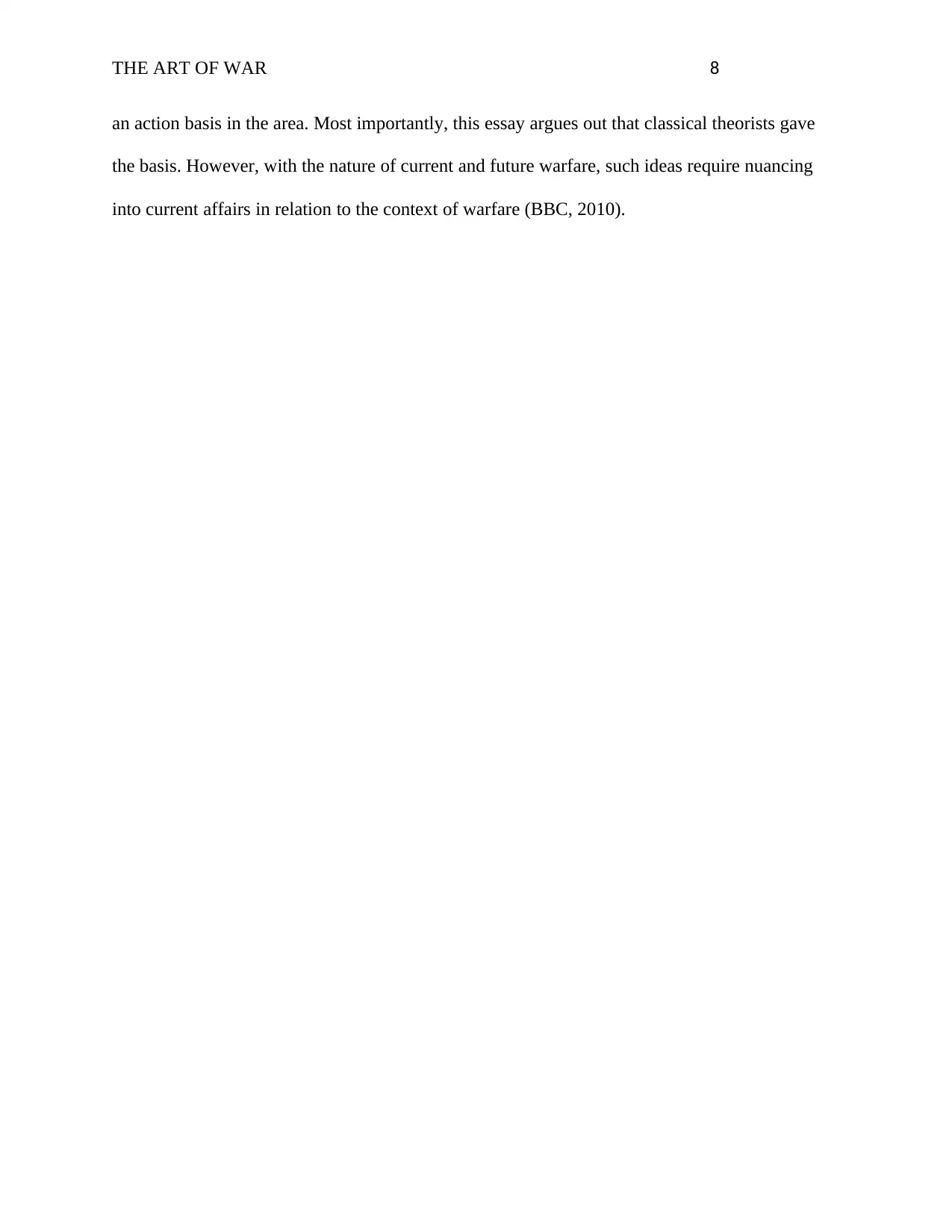
THE ART OF WAR 8
an action basis in the area. Most importantly, this essay argues out that classical theorists gave
the basis. However, with the nature of current and future warfare, such ideas require nuancing
into current affairs in relation to the context of warfare (BBC, 2010).
an action basis in the area. Most importantly, this essay argues out that classical theorists gave
the basis. However, with the nature of current and future warfare, such ideas require nuancing
into current affairs in relation to the context of warfare (BBC, 2010).
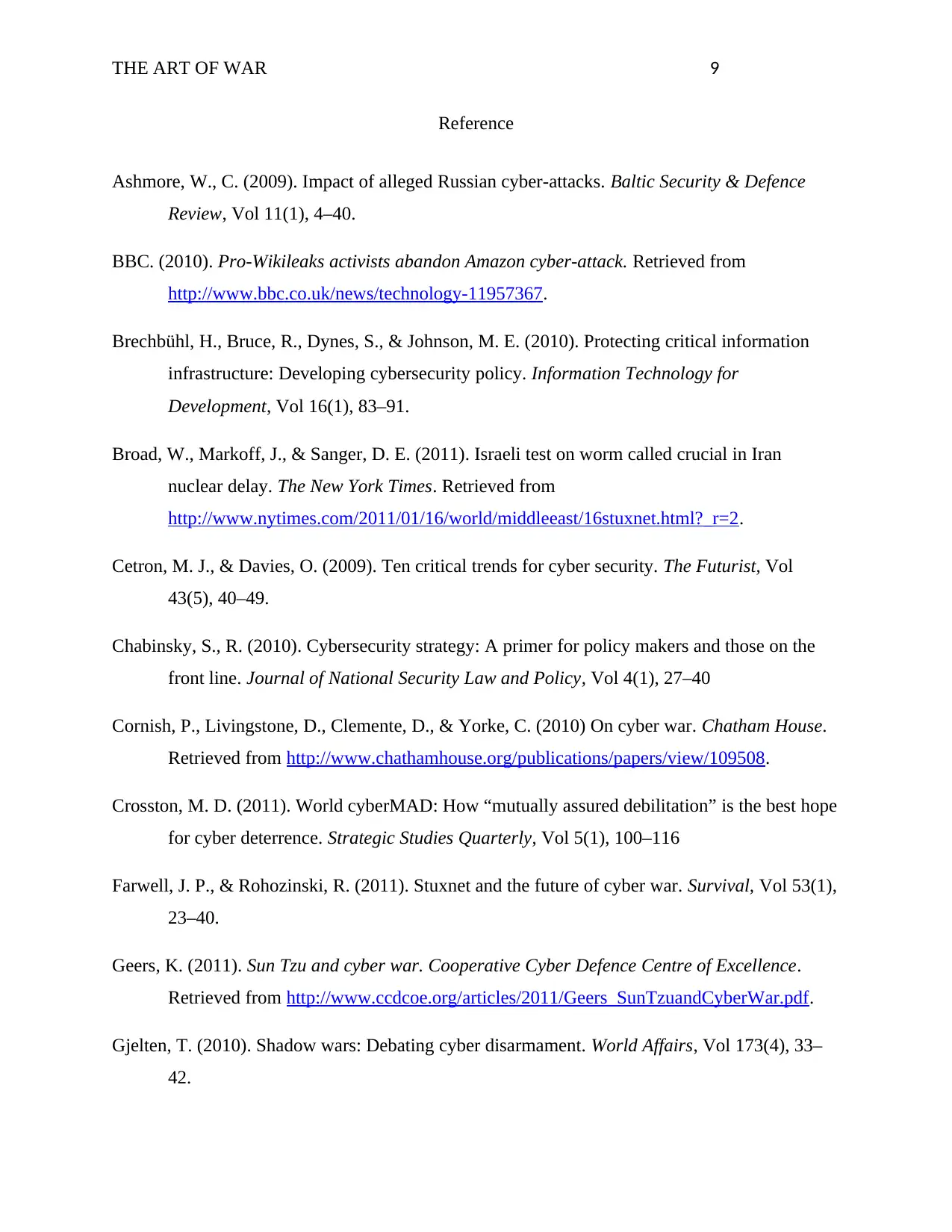
THE ART OF WAR 9
Reference
Ashmore, W., C. (2009). Impact of alleged Russian cyber-attacks. Baltic Security & Defence
Review, Vol 11(1), 4–40.
BBC. (2010). Pro-Wikileaks activists abandon Amazon cyber-attack. Retrieved from
http://www.bbc.co.uk/news/technology-11957367.
Brechbühl, H., Bruce, R., Dynes, S., & Johnson, M. E. (2010). Protecting critical information
infrastructure: Developing cybersecurity policy. Information Technology for
Development, Vol 16(1), 83–91.
Broad, W., Markoff, J., & Sanger, D. E. (2011). Israeli test on worm called crucial in Iran
nuclear delay. The New York Times. Retrieved from
http://www.nytimes.com/2011/01/16/world/middleeast/16stuxnet.html?_r=2.
Cetron, M. J., & Davies, O. (2009). Ten critical trends for cyber security. The Futurist, Vol
43(5), 40–49.
Chabinsky, S., R. (2010). Cybersecurity strategy: A primer for policy makers and those on the
front line. Journal of National Security Law and Policy, Vol 4(1), 27–40
Cornish, P., Livingstone, D., Clemente, D., & Yorke, C. (2010) On cyber war. Chatham House.
Retrieved from http://www.chathamhouse.org/publications/papers/view/109508.
Crosston, M. D. (2011). World cyberMAD: How “mutually assured debilitation” is the best hope
for cyber deterrence. Strategic Studies Quarterly, Vol 5(1), 100–116
Farwell, J. P., & Rohozinski, R. (2011). Stuxnet and the future of cyber war. Survival, Vol 53(1),
23–40.
Geers, K. (2011). Sun Tzu and cyber war. Cooperative Cyber Defence Centre of Excellence.
Retrieved from http://www.ccdcoe.org/articles/2011/Geers_SunTzuandCyberWar.pdf.
Gjelten, T. (2010). Shadow wars: Debating cyber disarmament. World Affairs, Vol 173(4), 33–
42.
Reference
Ashmore, W., C. (2009). Impact of alleged Russian cyber-attacks. Baltic Security & Defence
Review, Vol 11(1), 4–40.
BBC. (2010). Pro-Wikileaks activists abandon Amazon cyber-attack. Retrieved from
http://www.bbc.co.uk/news/technology-11957367.
Brechbühl, H., Bruce, R., Dynes, S., & Johnson, M. E. (2010). Protecting critical information
infrastructure: Developing cybersecurity policy. Information Technology for
Development, Vol 16(1), 83–91.
Broad, W., Markoff, J., & Sanger, D. E. (2011). Israeli test on worm called crucial in Iran
nuclear delay. The New York Times. Retrieved from
http://www.nytimes.com/2011/01/16/world/middleeast/16stuxnet.html?_r=2.
Cetron, M. J., & Davies, O. (2009). Ten critical trends for cyber security. The Futurist, Vol
43(5), 40–49.
Chabinsky, S., R. (2010). Cybersecurity strategy: A primer for policy makers and those on the
front line. Journal of National Security Law and Policy, Vol 4(1), 27–40
Cornish, P., Livingstone, D., Clemente, D., & Yorke, C. (2010) On cyber war. Chatham House.
Retrieved from http://www.chathamhouse.org/publications/papers/view/109508.
Crosston, M. D. (2011). World cyberMAD: How “mutually assured debilitation” is the best hope
for cyber deterrence. Strategic Studies Quarterly, Vol 5(1), 100–116
Farwell, J. P., & Rohozinski, R. (2011). Stuxnet and the future of cyber war. Survival, Vol 53(1),
23–40.
Geers, K. (2011). Sun Tzu and cyber war. Cooperative Cyber Defence Centre of Excellence.
Retrieved from http://www.ccdcoe.org/articles/2011/Geers_SunTzuandCyberWar.pdf.
Gjelten, T. (2010). Shadow wars: Debating cyber disarmament. World Affairs, Vol 173(4), 33–
42.
⊘ This is a preview!⊘
Do you want full access?
Subscribe today to unlock all pages.

Trusted by 1+ million students worldwide
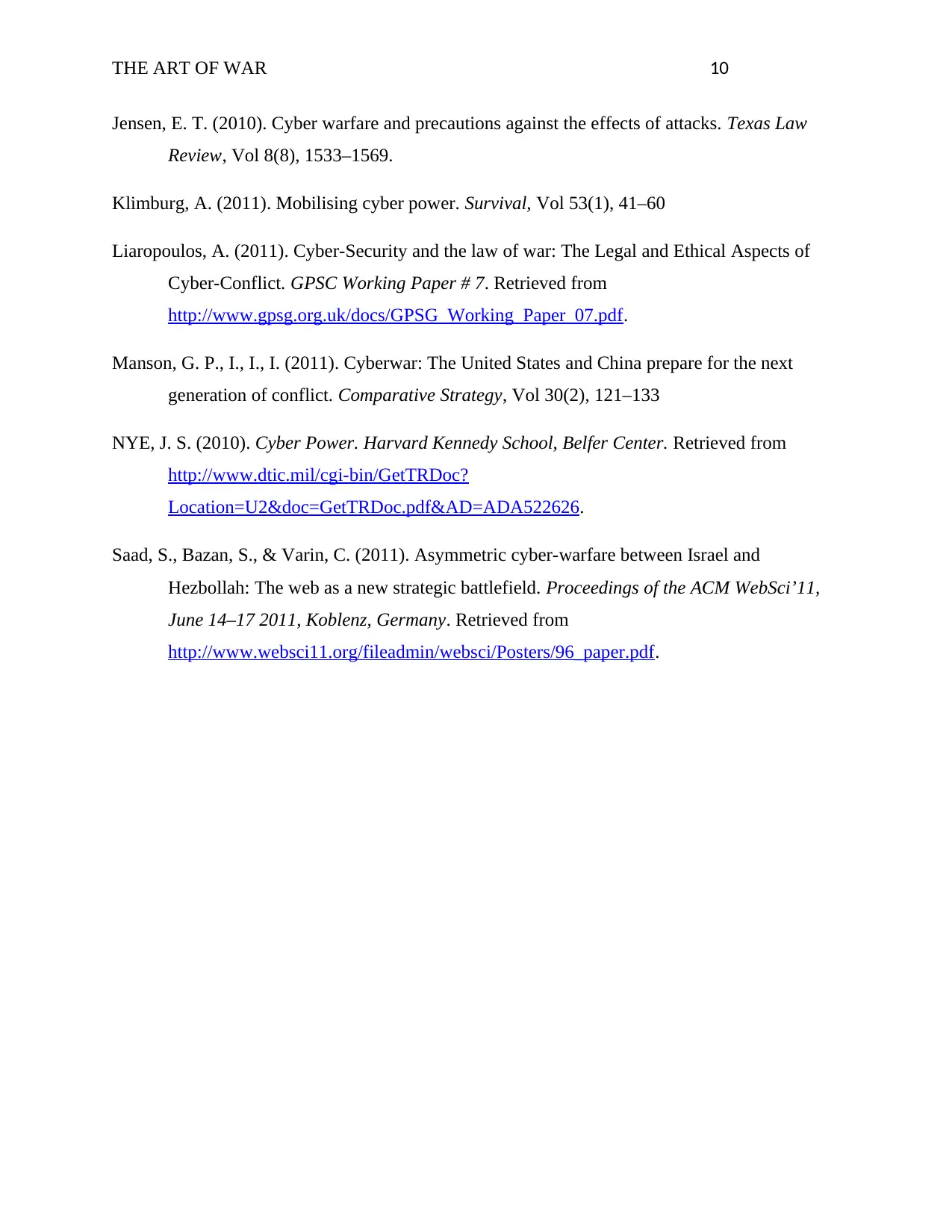
THE ART OF WAR 10
Jensen, E. T. (2010). Cyber warfare and precautions against the effects of attacks. Texas Law
Review, Vol 8(8), 1533–1569.
Klimburg, A. (2011). Mobilising cyber power. Survival, Vol 53(1), 41–60
Liaropoulos, A. (2011). Cyber-Security and the law of war: The Legal and Ethical Aspects of
Cyber-Conflict. GPSC Working Paper # 7. Retrieved from
http://www.gpsg.org.uk/docs/GPSG_Working_Paper_07.pdf.
Manson, G. P., I., I., I. (2011). Cyberwar: The United States and China prepare for the next
generation of conflict. Comparative Strategy, Vol 30(2), 121–133
NYE, J. S. (2010). Cyber Power. Harvard Kennedy School, Belfer Center. Retrieved from
http://www.dtic.mil/cgi-bin/GetTRDoc?
Location=U2&doc=GetTRDoc.pdf&AD=ADA522626.
Saad, S., Bazan, S., & Varin, C. (2011). Asymmetric cyber-warfare between Israel and
Hezbollah: The web as a new strategic battlefield. Proceedings of the ACM WebSci’11,
June 14–17 2011, Koblenz, Germany. Retrieved from
http://www.websci11.org/fileadmin/websci/Posters/96_paper.pdf.
Jensen, E. T. (2010). Cyber warfare and precautions against the effects of attacks. Texas Law
Review, Vol 8(8), 1533–1569.
Klimburg, A. (2011). Mobilising cyber power. Survival, Vol 53(1), 41–60
Liaropoulos, A. (2011). Cyber-Security and the law of war: The Legal and Ethical Aspects of
Cyber-Conflict. GPSC Working Paper # 7. Retrieved from
http://www.gpsg.org.uk/docs/GPSG_Working_Paper_07.pdf.
Manson, G. P., I., I., I. (2011). Cyberwar: The United States and China prepare for the next
generation of conflict. Comparative Strategy, Vol 30(2), 121–133
NYE, J. S. (2010). Cyber Power. Harvard Kennedy School, Belfer Center. Retrieved from
http://www.dtic.mil/cgi-bin/GetTRDoc?
Location=U2&doc=GetTRDoc.pdf&AD=ADA522626.
Saad, S., Bazan, S., & Varin, C. (2011). Asymmetric cyber-warfare between Israel and
Hezbollah: The web as a new strategic battlefield. Proceedings of the ACM WebSci’11,
June 14–17 2011, Koblenz, Germany. Retrieved from
http://www.websci11.org/fileadmin/websci/Posters/96_paper.pdf.
1 out of 10
Your All-in-One AI-Powered Toolkit for Academic Success.
+13062052269
info@desklib.com
Available 24*7 on WhatsApp / Email
![[object Object]](/_next/static/media/star-bottom.7253800d.svg)
Unlock your academic potential
Copyright © 2020–2025 A2Z Services. All Rights Reserved. Developed and managed by ZUCOL.